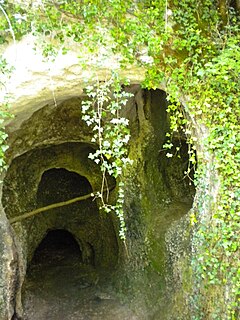 W
WThe Azilian is a name given by archaeologists to an industry in the Franco-Cantabrian region of northern Spain and southern France. It dates approximately 10,000–12,500 years ago. Diagnostic artifacts from the culture include Azilian points, crude flat bone harpoons and pebbles with abstract decoration. The latter were first found in the River Arize at the type-site for the culture, the Grotte du Mas d'Azil at Le Mas-d'Azil in the French Pyrenees. These are the main type of Azilian art, showing a great reduction in scale and complexity from the Magdalenian Art of the Upper Palaeolithic.
 W
WCave del Valle, locally also known as La Viejarrona, is located near El Cerro Village in the municipality of Rasines in Cantabria, northern Spain. The cave is the source of the Silencio River, a tributary of the Rio Ruahermosa, which in turn is a tributary of the Asón River. Notable for its prehistoric, but particularly for its speleologic significance as it is recognized as one of the longest cavities in the world. The site is very popular among cavers, who have explored a total of over 60 km (37.28 mi) so far.
 W
WThe Franco-Cantabrian region is a term applied in archaeology and history to refer to an area that stretches from Asturias, in northern Spain, to Aquitaine and Provence in southern France. It includes the southern half of France and the northern strip of Spain looking at the Bay of Biscay.
 W
WLe Mas-d'Azil is a commune in the Ariège department in southwestern France, containing a cave that is the typesite for the prehistoric Azilian culture. The Grotte du Mas d'Azil is a "supersite" with rich remains of human usage from about 30,000 years ago, and is also a key site for the preceding Magdalenian culture. The D119 road runs right through the large cave, which is a natural tunnel 420 metres long and 50 metres high.
 W
WÉdouard Louis Stanislas Piette was a French archaeologist and prehistorian.
 W
WRaymonden is a prehistoric cave near Chancelade in the French département Dordogne. The cave was inhabited during the Upper Paleolithic and contained, besides many artefacts, a human skeleton.
 W
WRochereil is a prehistoric cave near Lisle in the French département Dordogne. Besides around 4000 stone and bone artifacts it contained the tomb of an adult human, the perforated skull of a two-year-old child and fossilized bones of two adolescent individuals.
 W
WSantimamiñe cave, Kortezubi, Biscay, Basque Country, Spain, is one of the most important archaeological sites of the Basque Country, including a nearly complete sequence from the Middle Paleolithic to the Iron Age.